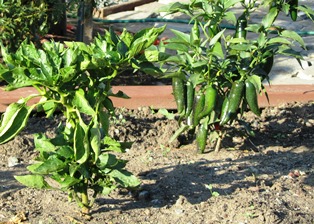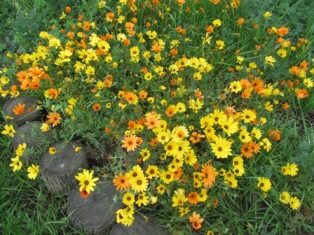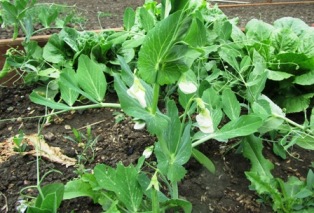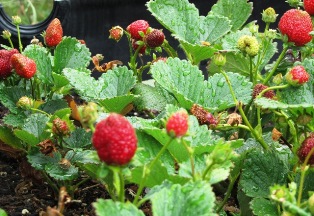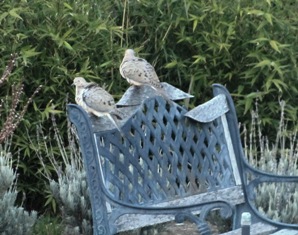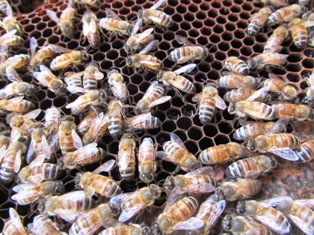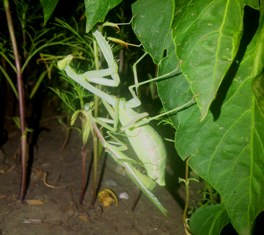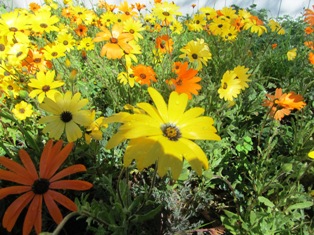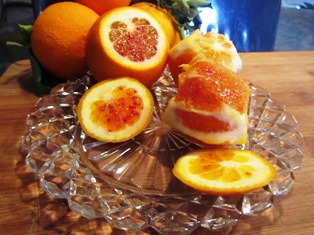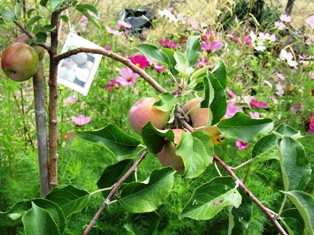Archive for the 'Plants and Trees' Category
Experiment with New Varieties of Tomatoes and Peppers
Tomatoes are one of my favorite plants from the summer garden. So it’s not surprising that of all the seed catalogs that I get each spring, the Tomato Growers catalog is one of my favorites. It offers 60 full-color pages of mostly tomatoes, but also peppers and eggplant varieties, a listing of equipment and supplies (for example tomato strainers), and books for gardeners. See, http://www.tomatogrowers.com/
I voraciously read all the catalog copy about each type of tomato and pepper and then note the seeds I want to grow. Experimenting with different varieties enables me to experience new flavors, new textures, and other unique characteristics of each variety.
In early spring when my neighbors rush off to garden centers for seedling tomatoes shipped to local nurseries by growers, I begin the process of planting my tomato and pepper seed in cell flats. The flats remain in the warm kitchen until the plants have emerged and have four sets of leaves. Only then do I place them in the garden to allow them time to acclimatize (harden off).
Removing the plants from their cell packs, I plant the seedlings in a basin or hole with native soil mixed with chicken manure or vegetable food. In that basin, the tomatoes benefit from the warmth of the sun and deep watering after transplanting. I do not plant the peppers in basins.
Stressing the tomato plant by withholding water yields tomatoes higher in flavor but can reduce the size and quantity. Too much water, however, can leach nitrogen and other nutrients from the soil and cause the plant to produce lots of leaves but fewer blossoms and fruit.
Near the heat-loving tomatoes in my garden, I always tuck in a few bell peppers, pickling peppers, and hot chili peppers. The Serrano peppers are pungent like jalapeno peppers and measure roughly 5,000 Scoville units of heat. Other peppers such as the Trinidad Perfume and the Fooled You peppers have no heat but are prized as seasoning for dishes requiring peppers.
A word of caution about growing tomatoes. Don’t plant them in the same area of your garden more than three years in a row. Experts say move them around as tomatoes are heavy feeders and putting them in depleted soil or soil in which you’ve grown tomatoes that have become sick can infect your new plants.
If you are interested in the pros and cons of dry farming tomatoes (meaning reduced watering) for intensive flavor and higher sugar content, check out the interesting article on the Growing For Market newsletter. See, http://www.growingformarket.com/articles/Improve-tomato-flavor
First Day of Spring Brings Rain and Wildflowers
Nothing says “Spring” more than showers and wildflowers, unless, of course, it’s lettuce and fresh peas. Here on the farmette today, we had them all. The wind blew through a shower of tropical moisture throughout the night and the sprinkles perked up the cool season vegetables growing in our garden.
This morning I discovered a patch of wildflowers blooming in riotous colors. In the grow boxes along one side of our property, the lettuces had swelled to into plump-and-ready-for-picking sizes. The sweet garden peas had set baby pods, and the onions were reaching skyward. I do hope the bulbs beneath the soil are swelling as well.
Spring is the best time of the year for new beginnings, new projects, and new plants. My spring vow? To grow something new that I’ve never grown before. I hope you will, too.
Wisteria Adds Drama to an Arbor or Trellis
I love the look of an arbor or trellis that makes a classical architectural statement in the garden. My husband Carlos has built a few of these. Most recently, he created a lovely trellis to support a decades-old wisteria that a neighbor had been growing in her garden.
Wisteria is a deciduous vine, meaning it loses its leaves in the winter and goes dormant. These vines are long lived, can be quite thick in diameter, and have lovely bracts of flowers in the spring, even before they sprout leaves.
It’s best to purchase wisteria that has already been grafted onto root stock or that has been grown from a cutting. These vines aren’t particular about soil, but they do need plenty of water and good drainage.
The other requirements are pruning and training. Wisteria can grow as much as 20 to 30 feet during the first year. I had a plant in San Jose that climbed a trellis and spilled over onto the roof in its very first year in that location.
I like tying the vines and the streamers to support them. Wisterias can be trained as shrubs (albeit large ones) or even as small trees. If planted on a bank or berm, they can spread quickly to vigorously cover the area.
I grew Wisteria floribunda in my San Jose garden, but here I’ve chosen Wisteria senesis (Chinese Wisteria) for the Henny Penny Farmette patio arbor (that we have yet to install). Chinese Wisteria blooms all at once in a beautiful violet-blue color before it leafs out in April-May. The blooms, which are more spectacular than the Japanese wisteria, are only marginally fragrant.
There is another variety of wisteria–Wisteria venustra–known as silky wisteria. The flowers are very large, long-stalked, and white. The plant blooms in short, heavy clusters that open all at once. Leaves break open in April. Another cultivar–Wisteria violacea has purple-blue flowers that are quite fragrant.
If you already have an amazing trellis or arbor, why not plant a wisteria next to it to add drama to your garden? It’s a vine sure to please year after year with ever-more spectacular blooms.
Spring and Strawberries Go Together
One of the easiest plants to grow, strawberries reward you with ripe, red, luscious fruit as early as April in California and Florida, and a couple of months later for the rest of the country.
I’ve planted dozens of strawberry plants in four-by-six- foot boxes that have a depth of around 12 inches. Most strawberry plants spread through runners. These runners are long, thin shoots that have leaves at their tips. Where the tips touch the soil, they root. The roots create daughter plants from the mother plants. This is good because you want to rejuvenate the beds to keep yields high. Otherwise, you’ll need to start with new plants every few seasons.
Strawberry plants love full sun and a sandy-loamy type of soil with good drainage.They need about an inch of water per week. If there is too much water and the drainage is not adequate, your berries may develop gray mold that rots the berries. The best way to deal with gray mold is to monitor the growing bed, keep it weed free, and pluck off any damaged or moldy fruit.
You’ll find four basic types of strawberries to choose from when you purchase your plants. June bearing berries produce their main crop in June with early, mid-season, and late-season cultivars.
Ever-bearing produce the main crop in June and a smaller crop in late August and otherwise produce a few berries throughout the summer. They have runners but far fewer than the June bearing berries that generate lots of runners that rapidly spread throughout the berry bed or box.
Day-neutrals are productive from June through August or until frost in Northern areas of the United States. Alpine strawberry plants produce smaller berries through summer until frost and have no runners.
I love home-grown berries. They are not necessarily as large as commercially grown strawberries, but mine are organic and the crop as bountiful as I want. There are enough berries to fill my morning bowl of yogurt, nuts, and honey and sometimes even enough berries to make jam. They are so easy to grow, I’ve planted two big earth boxes of them and am adding two more this year.
A Whole Lot of Coupling Going On
Lately, the way the birds, insects, and wild creatures are pairing up, you’d think we were on Noah’s Ark instead of the Henny Penny Farmette.
I’ve never seen such bird and bee traffic as in the last few days. This morning, I put on the bee suit and joined my neighbor on a tour of inspection to see if the bees survived the cold snap we had a week or so ago. We had snow on Mount Diablo and a hard frost elsewhere. But the bees are fine, and there are lots of babies.
Today, the yellow finches are congregating around the Nyjer feeder and singing their little hearts out. There’s a woodpecker in the neighborhood (maybe two). I haven’t seen it/them but there’s a whole lot of tap-tap-tapping in the nearby oak trees.
I often see a flash of blue as I work to move and amend the soil on our property. Last year about this time, pair of Western blue birds were scouting locations for a nest. They are back and I hope they stick around.
The plaintive coo-coo-coo of the mourning doves has become a chorus of late. At first, I noticed a pair in the back yard and now there are several pairs. They mate for life. So we’ve put out birdseed and I fully expect to see a nest or two being constructed in the next few weeks.
Birds and bees are either producing young or making preparations to produce offspring. But the praying mantises? Who knew?
So what I’m taking from all this pairing up is that Mother Nature expects warm days ahead. The wild creatures made it through the winter. No one has to tell them what to do now that spring is only weeks away. Like I said, it looks like Noah’s Ark around here.
February Color on the Farmette
It’s difficult to find color in the dead of winter. It’s the last week of February and around the farmette it’s beginning to look like spring. Mixed in with the drab brown and gray and green are dazzling splashes of orange and yellow.
On Sunday, my husband and I helped out a neighbor with the pruning of her fruit and citrus trees. My husband will also be removing her aged trellis, cutting back the Japanese wisteria and reducing the size of what looks to be a 20-year-old grape vine.
She had two orange trees both loaded with oranges, so there was harvesting to be done before we could even start pruning back the tree. One was a Valencia orange, known as the juice orange. I cut into several of them this morning and found them streaked with red. What came to mind was that perhaps the busy little honeybees had cross pollinated her Valencia with a Blood Orange. I’m growing several on the farmette.
Citrus trees need little pruning. It’s easy to thin the shoots and branches, rather than shortening the tree. You can also revitalize an old tree that is unproductive (my neighbor’s tree was old but still producing a lot of fruit) by pruning a little more severely but such a severe pruning can stop fruiting for one to two years.
Growers say to feed citrus four times a year; I feed mine once a month with a deep watering. Soils that don’t have good organic matter and nitrogen will benefit from compost, blood meal, cottonseed meal, and well rotted manure on the soil surface out to the drip line. If your citrus isn’t performing for you, try scratching around the surface of the soil under the tree. This stresses the surface roots. Citrus need good drainage. Water slowly and deeply.
We’ve been lucky to have a stretch of warm, sunny days here in Northern California at the end of February. The fruit and nut trees have burst into bloom. Around the farmette, there are pink and white buds opening on the apple, apricot, peach, and almond trees.
The field in the back is knee-high with wild mustard and its blooms are bright yellow on green stalks. The yellow and orange daffodils and purple hyacinths create a floral motif on the drab winter cloak of Mother Nature . . . at least here on the Henny Penny Farmette. Just another reason why I love living here.
Growing Greens
Early spring on the Henny Penny Farmette offers the perfect amount of sunshine, cool weather, and rain that lettuce and salad greens love. Lettuce is a cool-season crop and bolts in the heat, going to seed in the hot days of summer. Of course, from bolting comes seeds that you can harvest, dry, and plant another day.
Lettuce doesn’t demand much space to it can be tucked in around your garden almost anywhere. It likes nitrogen-rich soil that drains well and also retains moisture–in short, a rich humus type of soil. Lettuce plants have rather shallow roots and is almost 90 percent water. That means it needs lots of water (but again, good drainage).
Romain and Butterhead (or Boston) lettuce leaves are rich in nutrients whereas iceberg lettuce (that has leaves that are crisp and formed like cabbage) is the least nutritious. It lacks the abundant amount of Vitamins A and B that are found in other cultivars of lettuce (and there are many).
Plant lettuce seeds 1/4 inch deep and space your rows 1 1/2 feet apart. Bear in mind, that you will get a lot of lettuce from a single seed pack–approximately 80 heads or 50 pounds of leaves in a 100-foot-long row.
Successive plantings over smaller amounts will enable you to have greens for salads and sandwiches right up to the warm days of summer. Even in summer, if you plant heat-resistant types of lettuce and plant them in the shade, giving them plenty of water, you can eat lettuce throughout the summer. Then in midsummer, plant head lettuces to harvest until the first frost.
Try growing some greens for fresh salads. Most lettuce will keep up to around ten days to two weeks in the refrigerator.
Grafting Expands Fruiting Options
Last year during bare-root season, I purchased a multi-variety tree offering several types of apples, including the Fuji pictured above as well as Einsheimer. Sometimes spelled as Ein Schemer, this apple variety comes from Israel and has low-chill requirements, unlike some apples that need many hours of chilling. It’s a good choice for southwestern U.S. and Northern California gardens.
Anna and Beverly Hills are the other two varieties grafted onto my multi-apple tree. Such trees are ideal if you have limited space and cannot plant more than one tree. Apple trees also look lovely espaliered against a wall.
Apples live longer than many of the deciduous fruit trees. They have short fruit spurs that can produce apples for up to 20 years. The only pruning required is to remove dead, weak, damaged or crossed branches and twigs.
A true dwarf apple won’t exceed 5 to 6 feet in width and height; a semi-dwarf, however, can easily reach 10 to 15 feet. Apples like deep soil but many will tolerate less-than-ideal soil; even soil with poor drainage or clumpy clay soil. Some apples are self-fruitful and others need a pollinizer (which might not be a problem if you have other pollinizing apple trees in your neighbor’s yards.)
I took a class years ago through University of California (Santa Cruz extension) to learn grafting. The process is not difficult to master. And the only tool you truly need is a sharp knife to cut a piece of stem (called a scion). The scion must have a couple of growth buds on it.
Stock is the plant you will graft the scion onto. For example, you might want to graft an Anna variety apple scion onto a Fuji apple tree (stock). You will cut the scion from the Anna and insert that scion into into the Fuji. Select a scion roughly the same diameter as the stock branch (you will graft the scion onto). The union (when the graft succeeds) is a new branch that carries the Anna apple.
The tricky part of grafting is aligning the cambium layer of the scion with the cambium layer of the stock. So how do you find the cambium. Simple. The cambium is the tissue-thin layer between the bark and the inner wood of the tree.
Cut the end of the scion into a wedge (like an ax edge or a two-sided tip of an arrow) and also make a cut into the branch of the stock. Then slide the tip of your scion into the stock, making sure that cambium aligns with cambium. I like to then bandage the grafting area to hold the scion in place until the graft has taken.
There are other ways to graft, but this one has worked best for me. For western gardeners, Sunset’s Western Garden Book has great illustrations and directions for grafting. Also the following website for the University of Minnesota provides easy-to-follow instructions. See, http://www.extension.umn.edu/distribution/horticulture/dg0532.html.
You increase your chances for success if you graft like varieties to each other and also if you do the grafting during the dormant season before buds start showing up and swelling. Grafting expands your options for multiple varieties of fruits on the trees in your garden. Just remember to graft varieties of scion and stock that are botanically similar.
Forcing Blooms of Branches and Bulbs
If spring hasn’t arrived in your corner of the world, be of good cheer. You can effectively bring spring indoors by forcing bulbs to open or branches of spring-flowering trees to bloom in your home.
Trees that bloom in the spring need to have sufficient chilling hours before they break their dormancy, so it’s advisable to try forcing blooms during the months of January and February rather than in December.
Choose half-inch branches of golden forsythia, pussy willow, coral quince, or almost any fruit tree. Using sharp pruning shears or a knife, cut diagonally above a bud so that you have two- or three-feet long branches to force into bloom.
After bringing the branches indoors, you’ll want to cut slits into the bottom of the branches to ensure water is more easily absorbed. Put the branches in a container of water. Every other day, trim the stems and change the water. Bring in new branches every few days to ensure continuous blooms.
Nothing beats the paper-white narcissus or buttery yellow daffodil for brightening a kitchen on a dreary winter’s day. Choose healthy a bulb (or bulbs) free of bruising, cuts, of infection. In a bowl, glass, or saucer, place glass marbles or pebbles. Add water.
Position the bulb or bulbs securely so that the roots can grow down into the water, but the bulb remains out of the water sitting on top of the marbles or pebbles. Ensure that the water level beneath the bulb remains constant and add more water as necessary.
Paper-white narcissus, purple hyacinth, and certain daffodils add not only spring color to an indoor environment but also a lovely sweet scent wherever they are placed.
Plants Bees Love
Last summer, I saved the seed from the flower heads plucked out of the gardens around the Henny Penny Farmette (cosmos, zinnia, marigold, nasturtium, and others). Now that the weather has turned warm (and rain is forecast next week), now might be good time to plant those seeds.
I also want to put in some other plants that bees love. People who do not like bees buzzing around can use the list as a reference for what NOT to plant.
Plant open-pollinating plants and avoid hybridized seed that does not have the high pollen content that is most beneficial to the bees. See, http://thehoneybeeconservancy.org/act-today-2/plant-a-bee-garden/
LIST OF PLANTS FOR YOUR BEE GARDEN
abelia, acacia, Arenaria verna, artimesia, aster, savocado
bee balm, buddleia
callistemon citrinius (the bottlebrush shrub), calendula, calluna, ceanothus, Choisya ternata, citrus (all kinds), clover, cosmos, cotoneaster, crataegus
echinacea, echium, erica, eriogonum, escallonia, eucalyptus
feijoa, foxglove
gleditsia
heteromeles, hosta
iceplant
ligustrum (privet), Lonicera japonica (honeysuckle), Lonicera hildebrandiana
murraya paniculata
phyla nodiflora,polygonum capitatum, pyracantha
rosmarinus officinalis (rosemary)
salvia (sage), snapdragon, sorbus aucuparia, syzgium
Teucrium chamaedrys, thyme, Trachelospermum jasminoides (star jasmine)
wild lilac, wisteria, witch hazel
zinnia
While you are busily putting into the garden the plants bees love, why not put out a saucer of water with some large rocks or pebbles for them to stand on while they are drinking? Yes, honeybees get thirsty, too.
The gardens that attract bees are often gorgeous because of all the pollinating the bees do. When you plant the flowers bees love because of high pollen content and provide water, you are not only helping your garden to flourish, you are helping the beleagured honeybees. Our planet needs them.
 Facebook
Facebook Goodreads
Goodreads LinkedIn
LinkedIn Meera Lester
Meera Lester Twitter
Twitter





